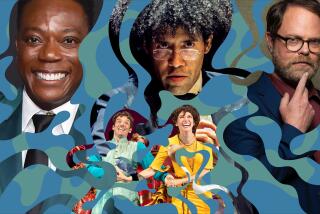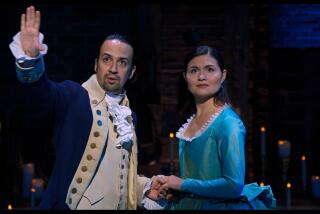
- Share via
In 1862, Abraham Lincoln held a forum to consider a potential solution to the country’s conflict: What if all free Black people left the U.S. and settled in Central America?
The president’s controversial proposal of Linconia is one of many historical events revisited in the new stage show “3 Summers of Lincoln,” which begins performances Tuesday at San Diego’s La Jolla Playhouse.
“What the president doesn’t understand is we are not aliens, not strangers of this land,” says Quentin Earl Darrington as Frederick Douglass in a scene. He then leads a chorus of Black men in a rousing gospel number that objects to the absurd suggestion:
We’re heirs to its glories, its sorrows and joys
Formed from the sweat of our men and our boys
So no time for silence, turn up the noise
We deserve the same fortune the white man enjoys
The world-premiere production, extended through March 30 due to strong advance ticket sales, musicalizes the unlikely friendship between the titular president and the noted abolitionist. The adversaries-turned-allies famously shaped the course of American history, even though the two leaders met in person only three times.
“These men were deeply in each other’s minds for years and fighting from afar through speeches and newspaper articles,” said La Jolla Playhouse artistic director Christopher Ashley, who helms the show. “They truly changed each other — Lincoln, for example, transforming from a careful politician to a bold action taker, largely because of Douglass — and together, they accomplished so much.
“But many of the problems they were grappling with are still with us,” he added. “So we’re all together trying to make a show that investigates that relationship and also speaks to the present moment.”

Any precursory comparisons to “Hamilton” are understandable, given that both stage musicals focus on an outspoken writer, a pivotal president and a years-long war that determined the country’s future. Both shows use contemporary genres to recount the past and star actors of color as white historical figures. (They even both break theater taboo by referencing the Scottish play by name.)
“‘Hamilton’ or ‘1776’ or anything doesn’t own the monopoly,” said “3 Summers of Lincoln” co-lyricist Daniel J. Watts who, along with fellow co-choreographer Jon Rua, are alumni of the Lin-Manuel Miranda phenomenon. “Yes, this show can’t exist without them, and we’re in conversation with all of them.”
Because of its Civil War setting, “3 Summers of Lincoln” centers on a topic “Hamilton” left out: slavery. And numerous scenes peek into closed-door meetings, with debates about who is allowed to enlist, who has the privilege to grieve and who deserves to enjoy America’s freedoms.
IAMA Theatre’s workshop production of Douglas Lyons’ time-travel adventure “Don’t Touch My Hair” runs through Feb. 24.
“One of the most interesting things about portraying this era is all the parallels to today, and how much these same conversations are happening over and over again,” said Saycon Sengbloh, who portrays seamstress and activist Elizabeth Keckley.
“You can tune into the Senate and the House of Representatives’ discussions, and they’re similar to those of the cabinet in our show, which is sad and also fascinating.”
The musical discusses these thornier topics matter-of-factly, not afraid to be frank about an ugly chapter of U.S. history. And yet, it’s entertaining, thanks to galvanizing anthems, contemplative ballads and spectacular tap numbers that track a game-changing invention: the telegraph.
“People are going to come to this possibly thinking they know what it might be about,” said Rua. “But because we’re approaching it in a very different way, this isn’t a history lesson. This is beyond all that.”

The vision wasn’t always so bold. During the pandemic, producers approached playwright Joe DiPietro about creating a theatrical piece solely about Lincoln, “who is already the most written about person in history, after Jesus Christ,” he recalled.
“My first thought: That’s a vast undertaking. Is Lincoln a good idea for a musical? How is it not a white-savior show? How would he sound in song? And how do we tell the truth in a way that doesn’t feel like homework?”
Upon further research, DiPietro grew intrigued by Lincoln in relation to Douglass; their three meetings took place during the president’s final years. “Even though they were antagonists who didn’t agree on a lot, they must have recognized something in each other — like, this guy is playing on my level,” said DiPietro, the show’s book writer and co-lyricist.
“These two giants must have found a deep respect for each other because they grew to become friends. Putting them both as leads in a story like this, that’s interesting.”
A new board of Trump allies makes him chairman of the Kennedy Center and fires the arts organization’s longtime leader, Deborah Rutter.
The story begins in 1862, early on in the Civil War. Before their first face-to-face onstage, each shares with the audience his private thoughts, public personas, family members and accomplishments thus far.
“Everybody has this idea of Lincoln as so reserved and put together, and he was, but he had his flaws and his blinders, and he must have struggled so immensely emotionally,” said Ivan Hernandez, who plays the president. “This great weight he carried, this responsibility he had; in a musical, you get to really hear him express these powerful ideas and emotions.”
“Most people know the CliffsNotes version of Frederick Douglass, and I didn’t even know the full depth of his impact until really diving into this role,” added Darrington.
“It says a lot about how history and race relations are taught in our country, considering who everyone knows and who we only know at the surface. It’s a shame that his story hasn’t been brought to light more, and it’s one of the most important things that we’re doing.”

When they do finally meet, “it’s an explosion, like the personification of an unstoppable force colliding with an immovable object,” said Watts. That collision is expressed not just in the dialogue but in the score, as only a musical can do.
“Throughout the show, they each have their own sonic identities — Lincoln is a bit measured and methodical and very pressed down, and Douglass is thunderous and flavorful right out of the gate, with nothing held back,” said composer Crystal Monee Hall.
“We then hear what they sound like together, and it’s this tingling intensity of when you actually meet your match. And after that scene, you can sonically hear their influence on each other.”
While the narrative jumps from boardrooms to battlefields, the production utilizes projection design to celebrate both Lincoln and Douglass’ well-known writings.
“We have two masters of language who expressed themselves with so much potency, confidence, clarity and lyricism,” said Ashley. “The projections mirror and amplify that as part of the visual vocabulary, whether that’s Douglass’ newspaper articles or autobiographies, or the text of the Emancipation Proclamation.”
Bernadette Peters and Lea Salonga star in ‘Stephen Sondheim’s Old Friends’ in a pre-Broadway run at the Ahmanson Theatre.
And even though the audience might know how the historical musical ends, “what’s most eye-opening about the show is to see the messy process of progress,” said Darrington.
“We often think a word is spoken, a document is signed, an action takes place and then it’s all tied up in a nice bow. But, my God, no. It’s a lot of failure, death and running away, because people at the time didn’t know exactly what to do. They might have known where they wanted to go but not how to get there because no one had done it before.”
“What we were trying to accomplish then, we’re still trying to accomplish,” echoed Carmen Cusack, who portrays Mary Todd Lincoln. “Right now, it seems like the darkest times in our world, and that we don’t know how to come together because it’s all so muddy. Even among people in my own family, I’ve never felt such a divide.
“What we can do as artists is use our craft, our skills and our hearts to keep the dialog open,” she added. “That’s the most important thing, that we not just run to our corners, but that we continue to talk about this.”
'3 Summers of Lincoln'
Where: Mandell Weiss Theatre, La Jolla Playhouse, 2910 La Jolla Village Drive, La Jolla
When: 7:30 p.m. Tuesdays-Fridays, 2 and 8 p.m. Saturdays, 1 and 7 p.m. Sundays. Ends March 30.
Tickets: Start at $30
Info: LaJollaPlayhouse.org, (858) 550-1010
Running time: TBA
More to Read
The biggest entertainment stories
Get our big stories about Hollywood, film, television, music, arts, culture and more right in your inbox as soon as they publish.
You may occasionally receive promotional content from the Los Angeles Times.














